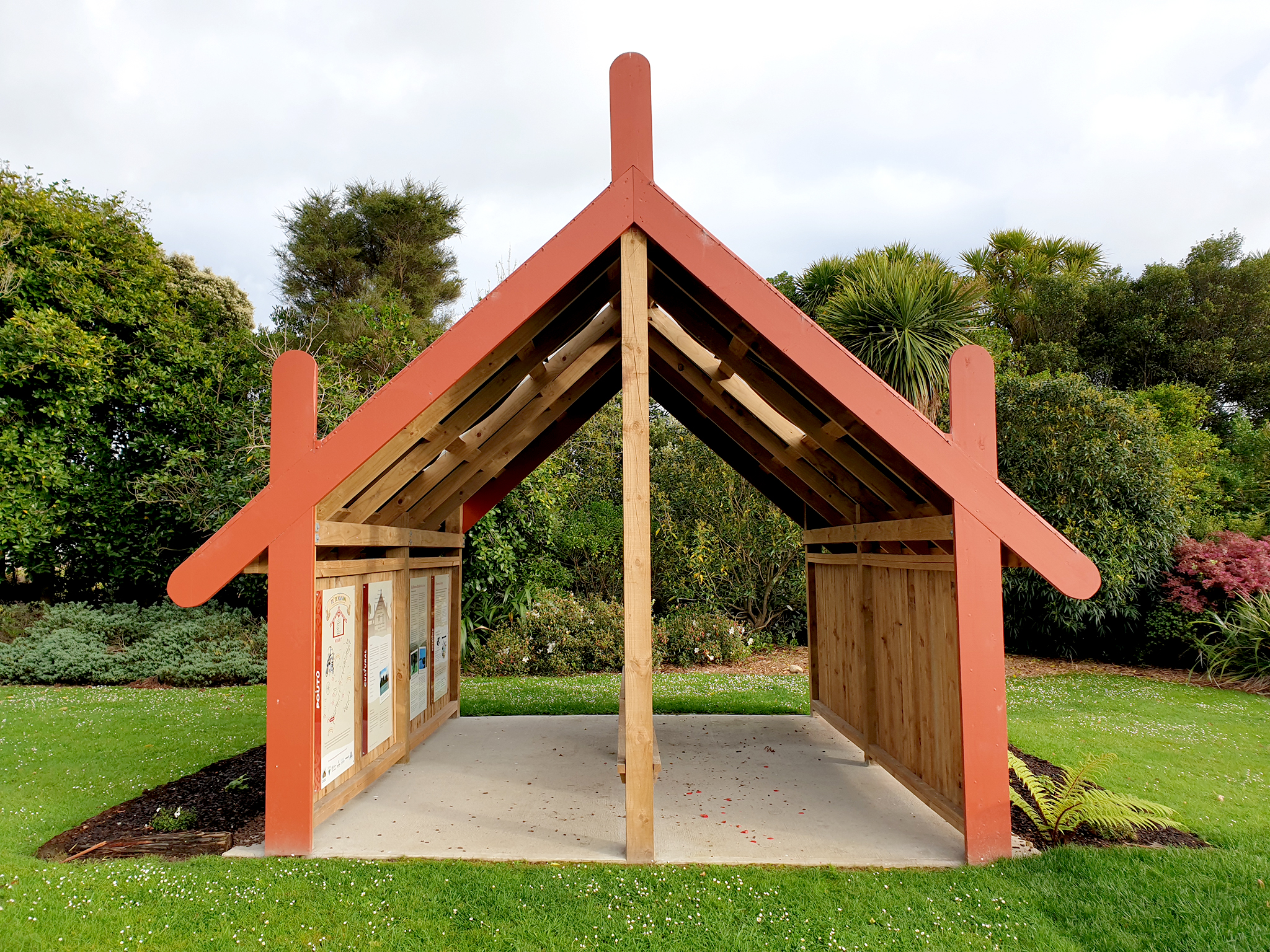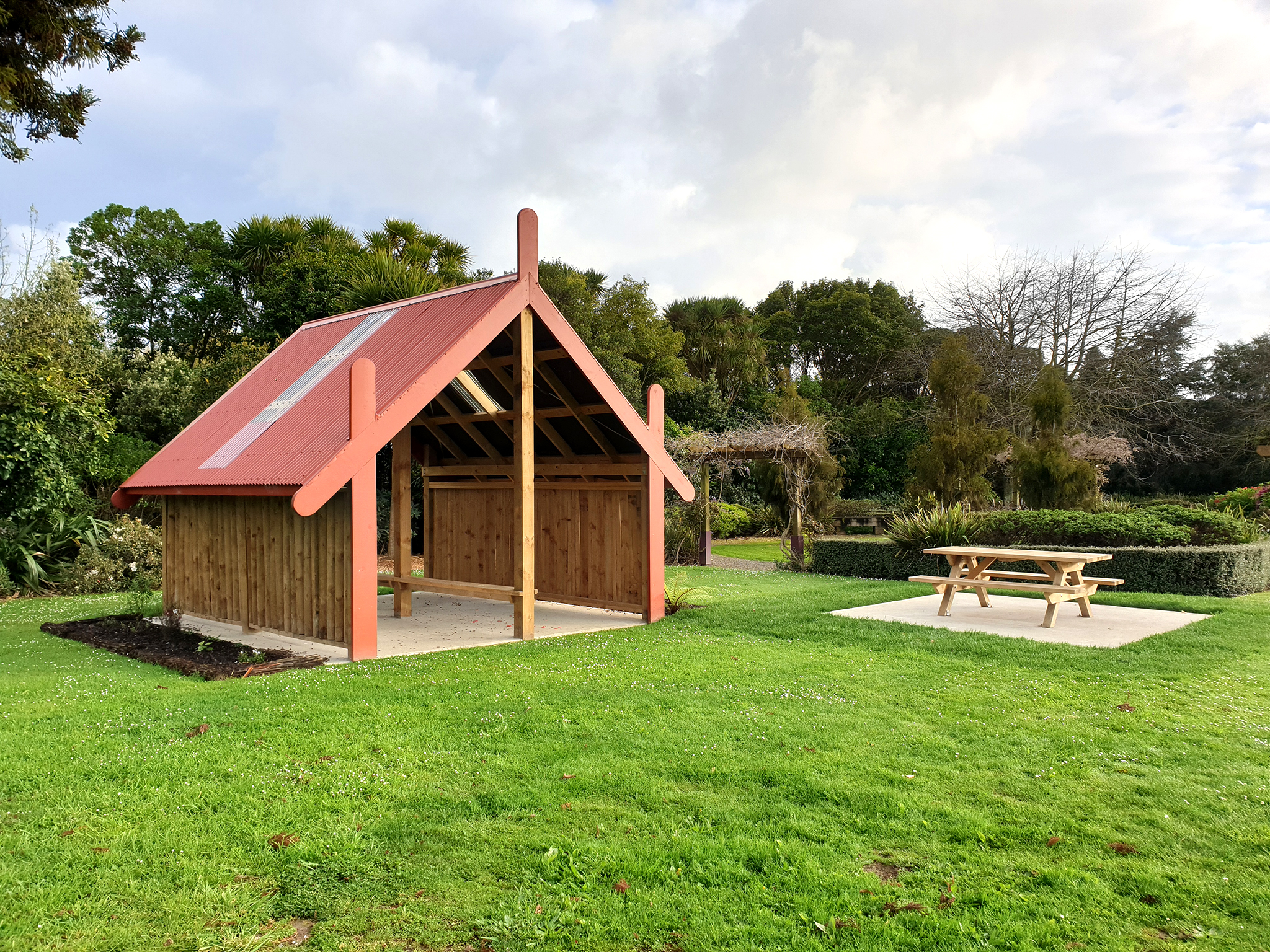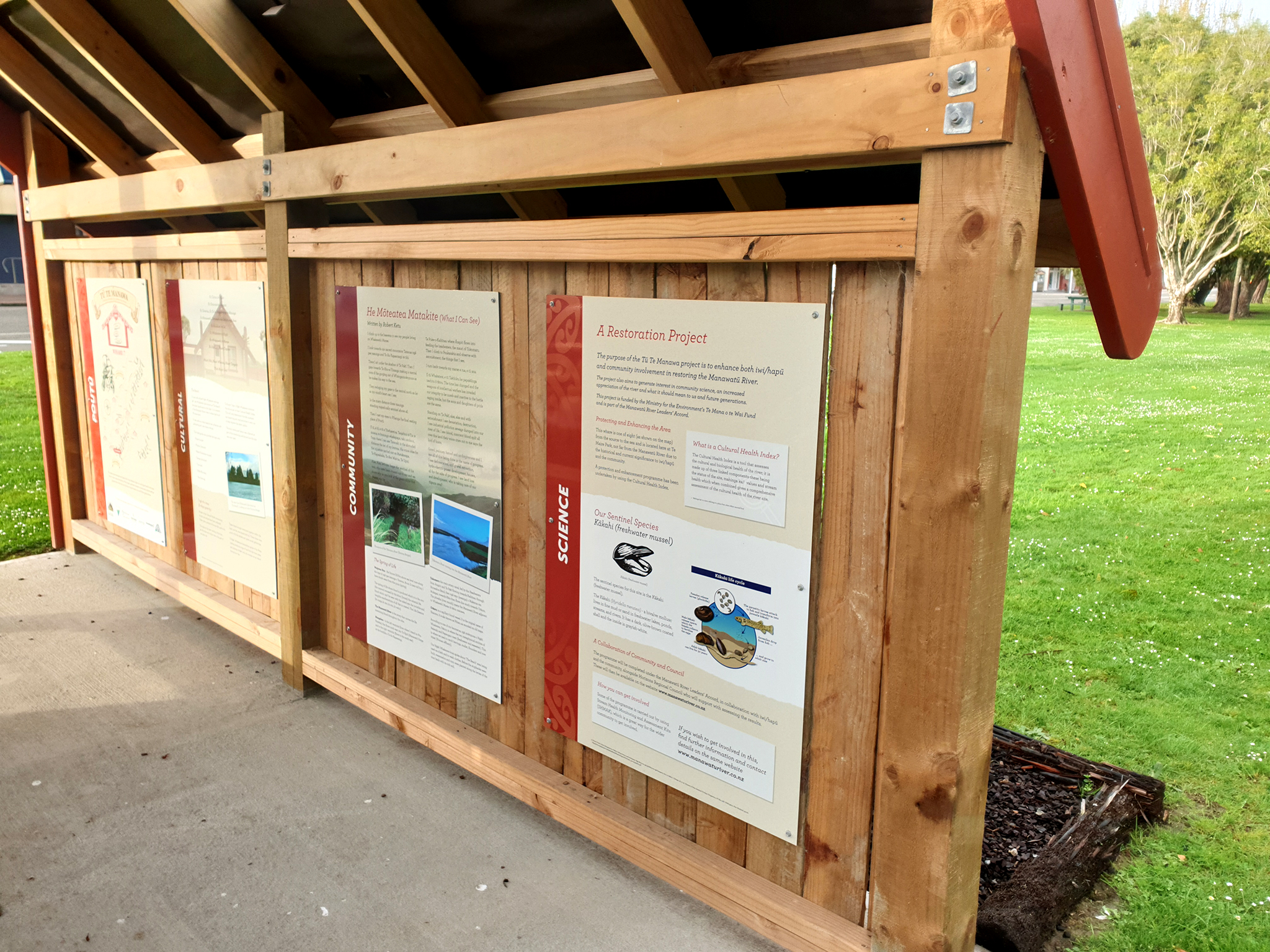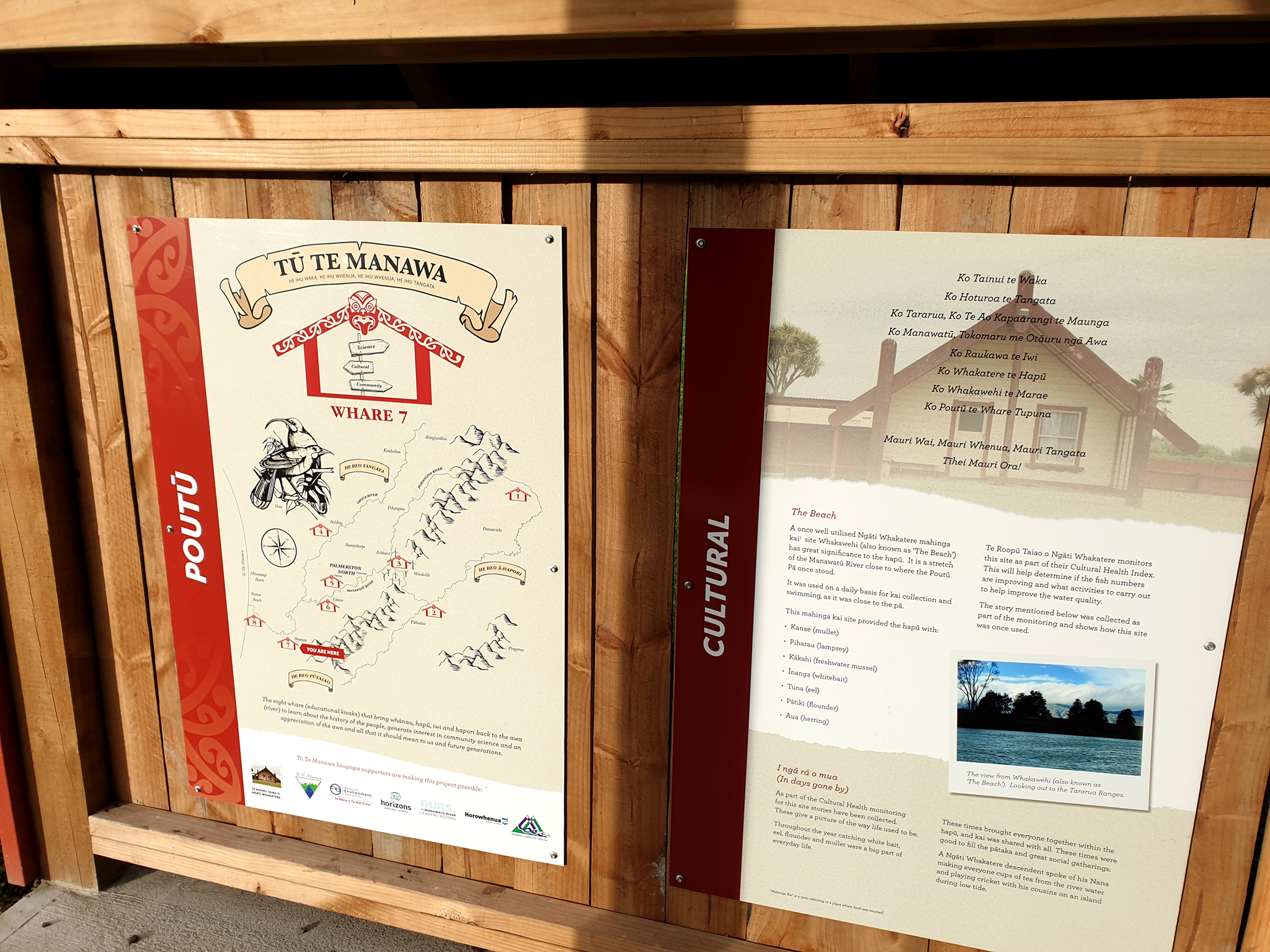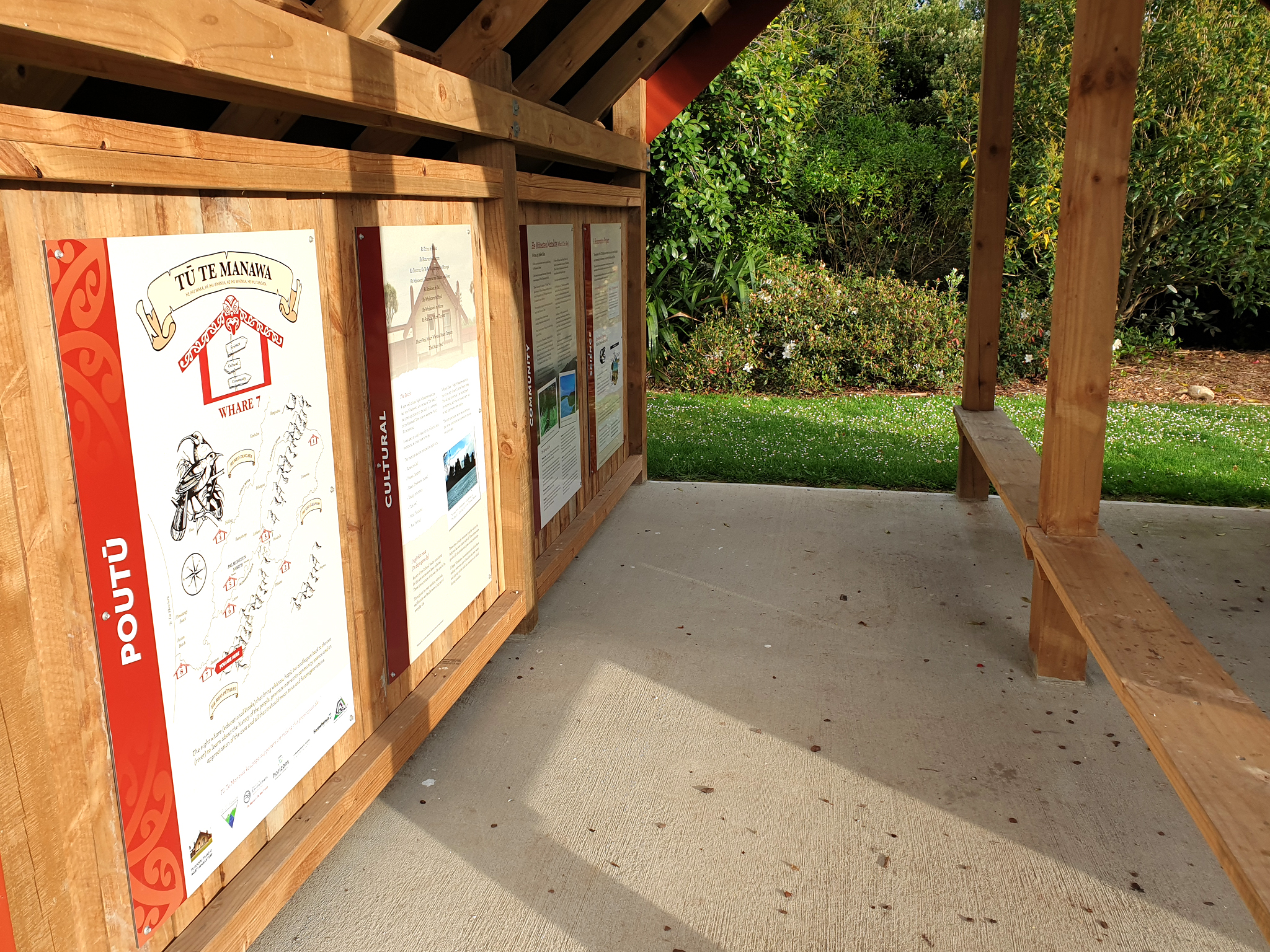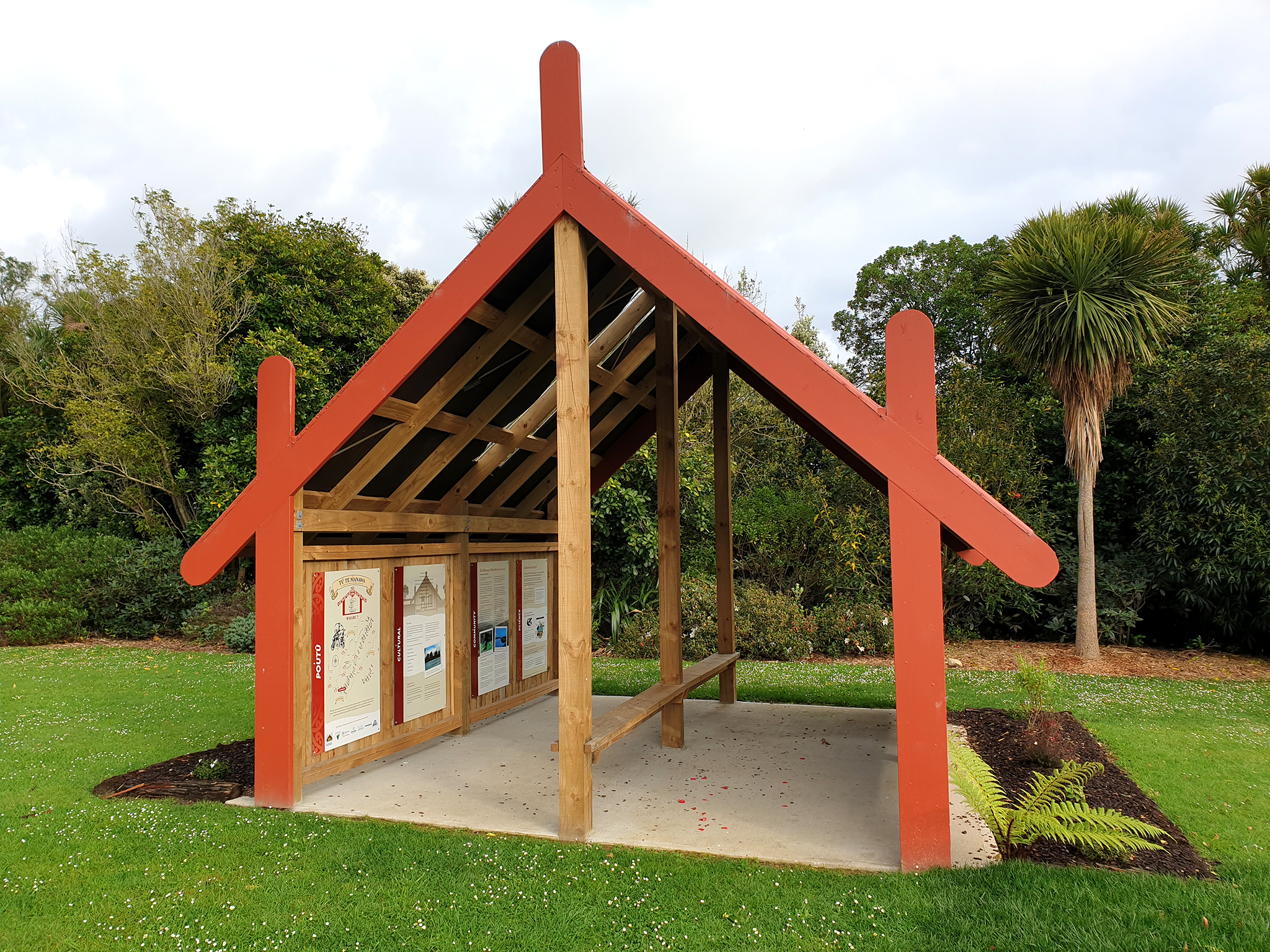He ihu waka, he ihu whenua, he ihu whenua, he ihu tangata
Tū Te Manawa
Tū Te Manawa is a kaupapa, erecting eight whare (educational kiosks) that bring whānau, hapū, iwi and community back to the awa.
The project also aims to generate interest in citizen science, and an increased appreciation of the river and what it should mean to us and future generations.
Tū Te Manawa has been funded by the Ministry for the Environment’s Te Mana o te Wai fund and is part of the Manawatū River Leaders’ Accord.
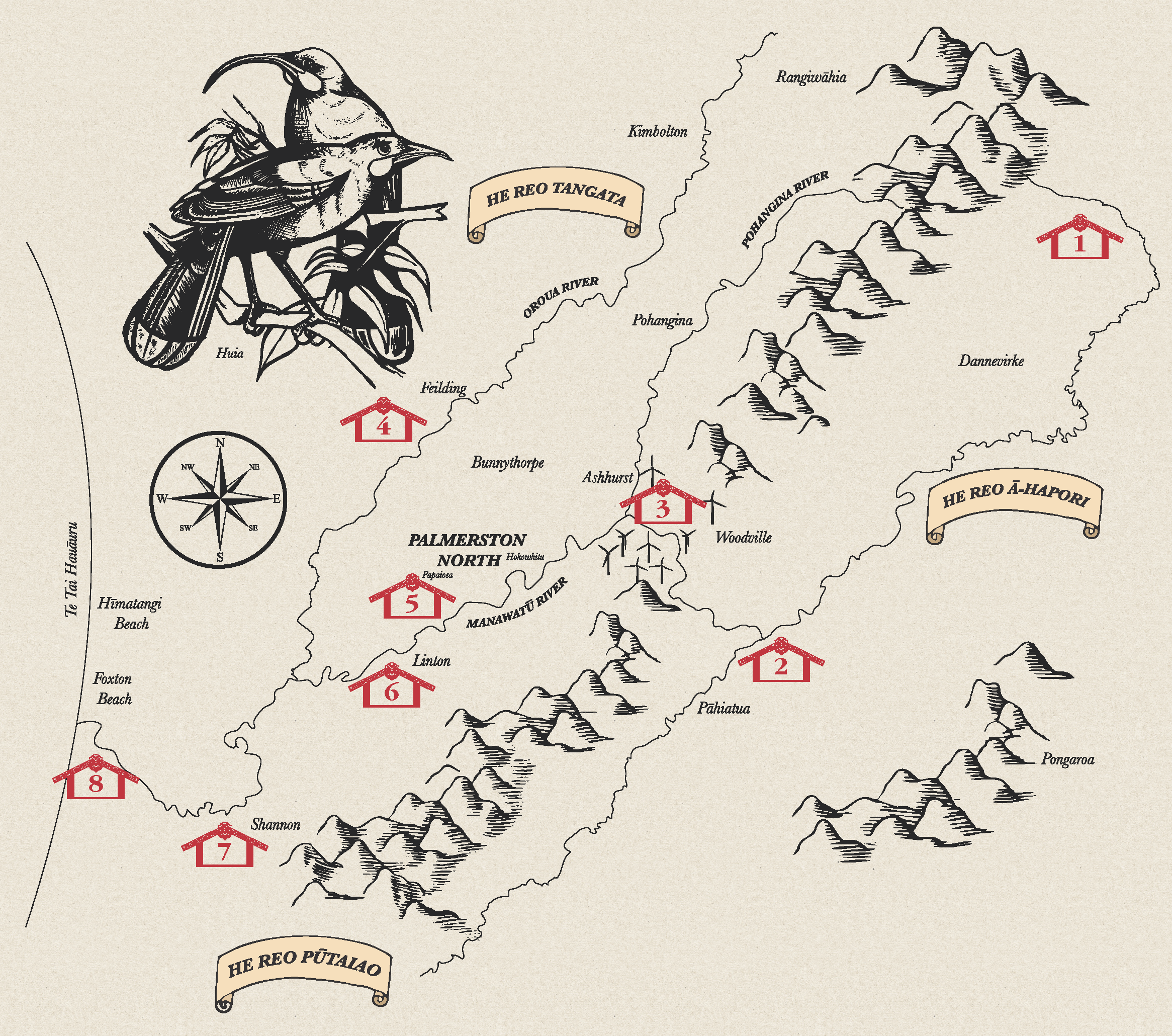
Te kōrero mō Tū Te Manawa
Story of Tū Te Manawa
Iwi and the awa
Hapū and iwi have a long and enduring connection to the Manawatū River and its tributaries, from Rangitāne o Manawatū, Raukawa Taiao, Muaūpoko and Ngāti Whakatere on the western side of the Ruahine and Tararua ranges, to the eleven hapū on the eastern side.
Utilising a creative hapū mātauranga model created by Punga Paewai at Kaitoki marae, hapū and iwi successfully applied to the Te Mana o te Wai Fund to establish similar models at eight iconic sites along the length of the Manawatū River (originally called Te Awa Pokere a Tamakuku on the eastern side). Called Whare Mātauranga (Educational Kiosks), they will provide a place for the community to gather and reconnect with the Manawatū River.
The whare tell the stories of the cultural and historical importance of each of the sites. Local hapū, iwi and the wider community are addressing water quality issues with an extensive riparian planting and fencing programme. A Cultural Health Index Monitoring (CHI) programme provides information to support local hapū/iwi groups to make decisions on the ongoing management of the river. Find out more about the sites developed so far below.
Puketōtara Whare
Te Rangimārie Marae, Rangiotū
Puketōtara
This whare is in Rangiotū, close to the convergence of the Oroua and the Manawatū Rivers. Both rivers give shape to the region and have long been part of our history, our environment and our survival. At the intersection of the Oroua and Manawatū Rivers is a collision of iwi and histories.
The Oroua and Manawatū Rivers acted as the main highway and trade routes that attracted Rangitāne, Ngāti Kauwhata and Raukawa iwi. Despite differences, an agreement was made to live amicably and to support and respect each other in the years ahead.
To this day Rangitāne, Ngāti Kauwhata and Raukawa are kaitiaki (guardians) of the two rivers. Together and individually, they strive to ensure that the Oroua River and Manawatū River remain pristine sources of pride for future generations. Visit the site to find out more.
Traditional
Mahinga Kai
Site of Significance
Pa site
Swim spot
Kanae (Grey Mullet)
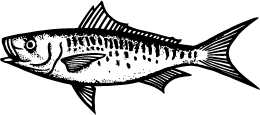
The Kanae or Mugil cephalus were considered to be a highly nutritious and attractive food source for Māori, rich in fat and protein and especially suitable for smoking. They grow to about 500 mm in length. Grey mullet are mostly a marine species but can be found wandering into freshwater and penetrate a long way inland from the sea. They must however, return to sea to spawn. When in freshwater they feed on detritus and plant material that they suck from the substrate. They are also known to feed by grazing the surfaces of aquatic plants. Kanae evade predators by acrobatically leaping out of the water. Where the Kanae live it is a familiar sight to see the gleaming flash as a mullet leaps out of the water and returns to its element with a resounding splash.
Cultural Health Index Monitoring Scores
Scores are currently being calculated for this site, they will be shared here when this process is completed.
Site status: A-1
Mahinga kai: –
Stream health score: –
A – identifies the site as traditional
B – identifies the site as non-traditional
0 – identifies that the site will not be used in the future
1 – identifies that the site will be used in the future
Mahinga kai score
1 – poor mahinga kai values
2.5 – average mahinga kai values
5 – excellent mahinga kai values
Stream health score
1 – poor stream health
2.5 – average stream health
5 – excellent stream health
Actions
Whare Build – complete
Riparian planting and fencing – complete
Community that cares Group – complete
Narratives-Signage – in progress
Cultural Health Monitoring – ongoing
Ngāmoko Whare
Manawatū River Road, Norsewood
Ngāmoko
This whare is located at Ngāmoko, or Norsewood, alongside the Manawatū River. The site and area take their name for the two grandchildren of Rongotautāwhi. The two big hills directly above the whare are brother and sister, known together as Ngā Mokopuna o Rongotautāwhi.
The whare is surrounded by over 5000 native riparian plants, planted by the community, and is an important spawning ground of the native fish kōkopu (dwarf galaxia).
Visit this beautiful spot for yourself to find out more.
Traditional
Mahinga Kai
Site of Significance
Kōkopu (Dwarf galaxais)

These Kōkopu also known as Galaxias divergens are non-migratory completing their entire life cycle in small fresh water streams. They are a small fish that are usually less than 70mm in length when fully grown. Adults spawn in spring-early summer with larvae taking about three weeks to develop and hatch. Dwarf galaxias feed on small stream invertebrates and occasionally eat terrestrial insects (insects that live on the land). During the juvenile growing phase juvenile dwarf galaxias can often be seen in their hundreds darting around in slow moving areas such as pools or back waters as they are too small to be able to handle the strong currents within riffles and runs that would wash them away. Dwarf galaxias are particularly susceptible to predatory effects from introduced trout species and can often be found in high abundance in areas that have barriers to trout migrating into them.
Cultural Health Index Monitoring Scores
Scores are currently being calculated for this site, they will be shared here when this process is completed.
Site status: A-1
Mahinga kai: –
Stream health score: –
A – identifies the site as traditional
B – identifies the site as non-traditional
0 – identifies that the site will not be used in the future
1 – identifies that the site will be used in the future
Mahinga kai score
1 – poor mahinga kai values
2.5 – average mahinga kai values
5 – excellent mahinga kai values
Stream health score
1 – poor stream health
2.5 – average stream health
5 – excellent stream health
Actions
Whare Build – complete
Riparian planting and fencing –complete
Community that cares Group –complete
Narratives-Signage –complete
Cultural Health Monitoring – ongoing
Ngāawapūrua Whare
Bluff Road, Pahiatua
Ngāawapūrua
This whare is near the confluence of three mighty rivers, the Tiraumea, Mangatainoka and the Manawatū. Before there was a main road and a bridge the best way to cross the rivers was with the Ngāawapūrua ferry service. The service was started and run by renowned chief Nireaha Tamaki in the 1870s, ensuring safe passage for iwi and early settlers alike.
There was once a pā site at Ngāawapūrua situated on the river’s edge, where the community tended mara (gardens) and collected kākahi (fresh water mussels). Today this site remains very special to the community, providing great fishing, family outings and a quiet spot to reflect and take time out. Visit the site to find out more.
Traditional
Mahinga Kai
Pa site
Site of Significance
Swim spot
Kōkopu (Redfin Bully)
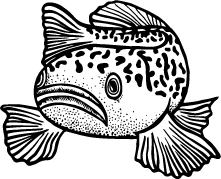
The Kōkopu or Gobiomorphus huttoni is a small freshwater fish endemic to New Zealand. You can spot them out by the unique diagonal stripes on their cheeks. Male Kōkopu also have distinctive bright red patterns and stripes on their fins. They can be found in runs and pools of small boulder filled streams and their principal food is mayfly, caddis fly and chironomid larvae. They are amphidromous which means Kōkopu spend part of their life cycle at sea. Kōkopu populations are severely impacted if their migration routes are blocked or if there is excess sediment in the water.
Cultural Health Index Monitoring Scores
Site status: A-1
Mahinga kai: 3.5
Stream health score: 2.6
A – identifies the site as traditional
B – identifies the site as non-traditional
0 – identifies that the site will not be used in the future
1 – identifies that the site will be used in the futureA – identifies the site as traditional
Mahinga kai score
1 – poor mahinga kai values
2.5 – average mahinga kai values
5 – excellent mahinga kai values
Stream health score
1 – poor stream health
2.5 – average stream health
5 – excellent stream health
Actions
Whare Build –complete
Riparian planting and fencing –complete
Community that cares Group –complete
Narratives-Signage – complete
Cultural Health Monitoring – ongoing
Te Waha o te Kurī Whare
Ferry Reserve, Woodville
Te Waha o te Kurī (Ferry Reserve)
According to Rangitāne tradition, the Manawatū Gorge was formed by a giant tōtara tree known as Okatia, who once stood on the Puketoi ranges to the east. Okatia became incensed with a desire to reach the sea and so headed west from its Puketoi home and encountered the great Ruahine and Tararua mountain range. This it overcame, creating in its wake a great mountain pass which became known as Te Āpiti (the Manawatū Gorge).
At the mouth of Te Āpiti is Te Waha o te Kurī (Ferry Reserve), for over 100 years it has played an important role as the crossing point to and from Palmerston North to the west and as an interface between the Manawatū River and the community. As well as being historically and culturally significant, Te Waha o te Kurī has become a prominent resting point and picnic area for visitors and residents alike. Visit the whare to find out more about this special spot.
Traditional
Mahinga Kai
Site of Significance
Tuna (Eel)

Western science identifies two indigenous tuna species in New Zealand, the shortfin eel (Anguilla australis) and the longfin eel (Anquilla dieffenbachii). The long-fin eel is one of the largest eels in the world, it’s unique to New Zealand and is found in our rivers and streams.
Cultural Health Index Monitoring Scores
Scores are currently being calculated for this site, they will be shared here when this process is completed.
Site status: A-1
Mahinga kai: –
Stream health score: –
A – identifies the site as traditional
B – identifies the site as non-traditional
0 – identifies that the site will not be used in the future
1 – identifies that the site will be used in the future
Mahinga kai score
1 – poor mahinga kai values
2.5 – average mahinga kai values
5 – excellent mahinga kai values
Stream health score
1 – poor stream health
2.5 – average stream health
5 – excellent stream health
Actions
Whare Build – complete
Riparian planting and fencing – complete
Community that cares group – complete
Narratives-Signage – complete
Cultural Health Monitoring – ongoing
Hokowhitu Whare
Hokowhitu, Waterloo Park Reserve
Hokowhitu
The name Hokowhitu derives from the military strength of Rangitāne o Manawatū in earlier times. The Hokowhitu Lagoon was an important water source and one of the largest settlements of Rangitāne o Manawatū. Hokowhitu was an important mahinga kai site, the surrounding forest was filled with tōtara and kahikatea and there was an abundance of berries; making it a great home for birds like pūkeko, kererū, kākā, tūī and kākāriki.
A number of significant pā and kāinga existed in this area including Pīhauatua, Whakarongo, Te Matai, Te Awa Kararoa, Tapuihouhou and Hokonui.
Visit this site located alongside the Manawatū River at Hokowhitu in Waterloo Park Reserve, Palmerston North.
Traditional
Site of Significance
Tuna (Eel)

Rangitāne o Manawatū have over 109 names for tuna, reflective of their different life stages, or sizes or varieties. While a few important food species may have had up to a dozen Māori names, most have only one or two, and the large number of names associated with freshwater tuna reflects their socioeconomic importance to wider Māori and the special place of tuna in Rangitāne o Manawatū culture.
Western science identifies two indigenous tuna species in New Zealand, the shortfin eel (Anguilla australis) and the longfin eel (Anquilla dieffenbachii). The long-fin eel is one of the largest eels in the world, it’s unique to New Zealand and is found in our rivers and streams.
Cultural Health Index Monitoring Scores
Scores are currently being calculated for this site, they will be shared here when this process is completed.
Site status: A-1
Mahinga kai: –
Stream health score: –
A – identifies the site as traditional
B – identifies the site as non-traditional
0 – identifies that the site will not be used in the future
1 – identifies that the site will be used in the future
Mahinga kai score
1 – poor mahinga kai values
2.5 – average mahinga kai values
5 – excellent mahinga kai values
Stream health score
1 – poor stream health
2.5 – average stream health
5 – excellent stream health
Actions
Whare Build – complete
Riparian planting and fencing – N/A
Community that cares Group – complete
Narratives-Signage – complete
Cultural Health Monitoring – ongoing
Poutū Whare
Foxton Shannon Road, Shannon
Poutū Whare
This whare is at the meeting place of the Manawatū and Tokomaru rivers. Located near the Whakawehi Marae, known locally as the Poutū Marae.
Close by is ‘The Beach’ close to where the Poutū pa once stood, a much loved place for the community to come together, to play, grow, and interact with the awa. It’s still a special spot to this day and the community is working to rejuvenate it through the Tū Te Manawa programme and applying the Cultural Health Index monitoring system. Come and see what’s been going on at this whare.
Traditional
Mahinga Kai
Site of Significance
Pa site
Swim spot
Kākahi (Fresh water mussel)

The Kākahi or Hyridella menziesi is a bivalve mollusc which means it has a compressed body that is enclosed within a hinged shell. They live in fine mud or sand in freshwater lakes, ponds, streams and rivers. The Kākahi has a dark, olive-brown coated shell and the inside is grayish-white.
Cultural Health Index Monitoring Scores
Site status: A-1
Mahinga kai: 3.5
Stream health score: 1.8
A – identifies the site as traditional
B – identifies the site as non-traditional
0 – identifies that the site will not be used in the future
1 – identifies that the site will be used in the future
Mahinga kai score
1 – poor mahinga kai values
2.5 – average mahinga kai values
5 – excellent mahinga kai values
Stream health score
1 – poor stream health
2.5 – average stream health
5 – excellent stream health
Actions
Whare Build – complete
Riparian planting and fencing – N/A
Community that cares Group – complete
Narratives-Signage – complete
Cultural Health Monitoring – ongoing
Te Ngau o Tapa Te Whata Whare
Kitchener Park, Feilding
This site is in development, stay posted for updates.
Te Pou o Papangaio
Foxton
This site is in development, stay posted for updates.
Sentinel Species
A sentinel species has been selected by the hapū/iwi of each site as it is significant to them and is specific to that area. As part of the Tū Te Manawa project hapū/iwi and Horizons Regional Council are working together to protect the habitat of these unique native species. This includes stream health and population monitoring, community planting, fencing, and environment enhancement at the sites. Success is measured using the Cultural Health Index, a system grounded in an iwi perspective of stream health and cultural values. Find out more about these native species by exploring each whare web page and by visiting the Tū Te Manawa sites.

Measuring cultural health
The success of the Tū Te Manawa project is measured using the Cultural Health Index system (CHI). All aspects of the CHI are grounded in an iwi perspective of stream health and apply cultural values determined by the iwi/hapū. The CHI is made up of three linked components. Each component is assessed separately by the iwi/hapū and then all three are combined to provide a Cultural Health measure. Combining the three components – status of the site, mahinga kai values and stream health – gives a comprehensive assessment of the Cultural Health of the river site. The three part Cultural Health Index is expressed as a string, as shown in the following example.
A – identifies the site as traditional
B – identifies the site as non-traditional
0 – identifies that the site will not be used in the future
1 – identifies that the site will be used in the future
Mahinga kai score
1 – poor mahinga kai values
2.5 – average mahinga kai values
5 – excellent mahinga kai values
Stream health score
1 – poor stream health
2.5 – average stream health
5 – excellent stream health
Resources
Cultural Health Index Monitoring Programme Factsheet
Find out more about the Cultural Health Index Monitoring programme, and how we use it to measure the success if the Tū Te Manawa project.





























